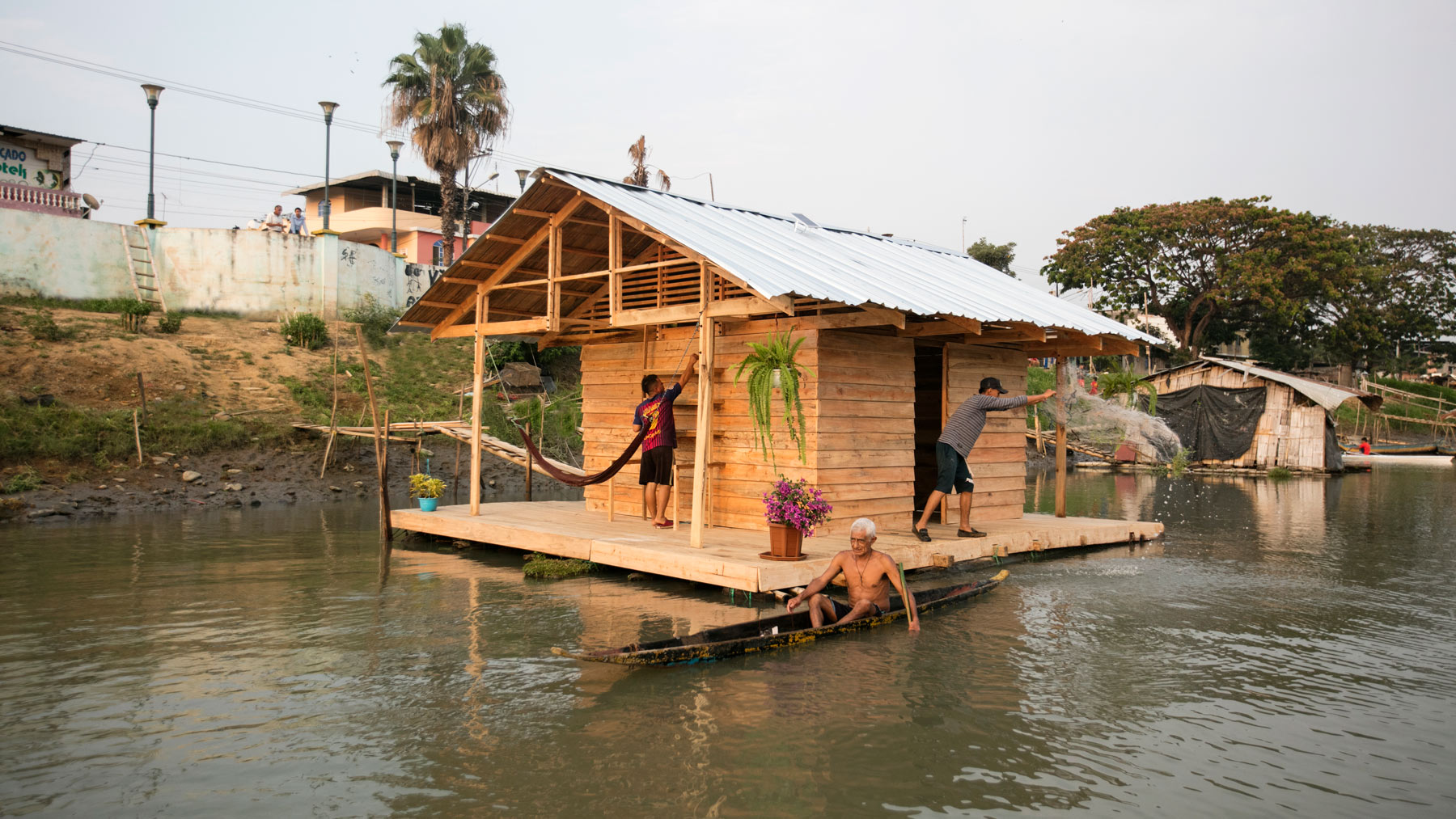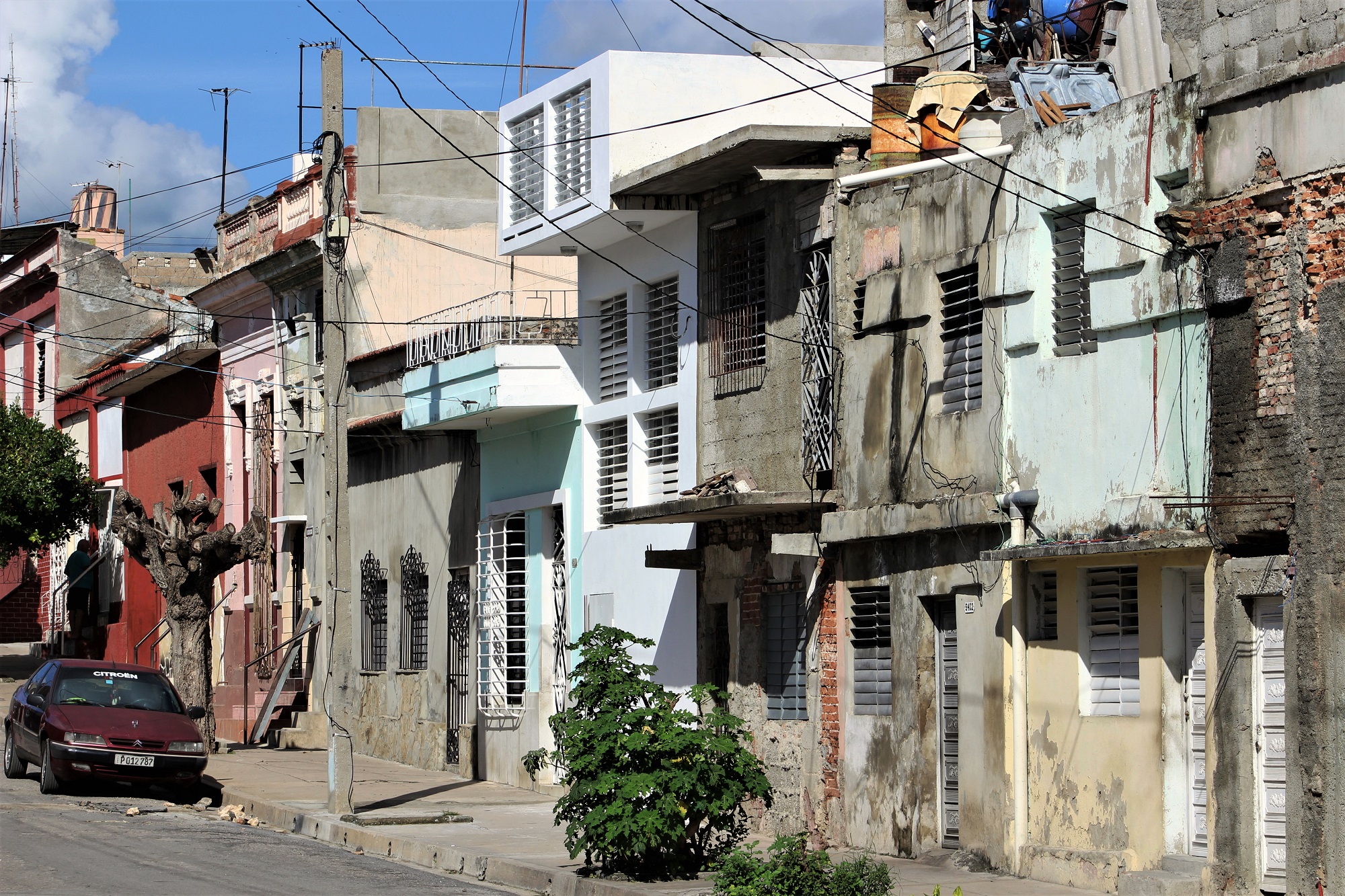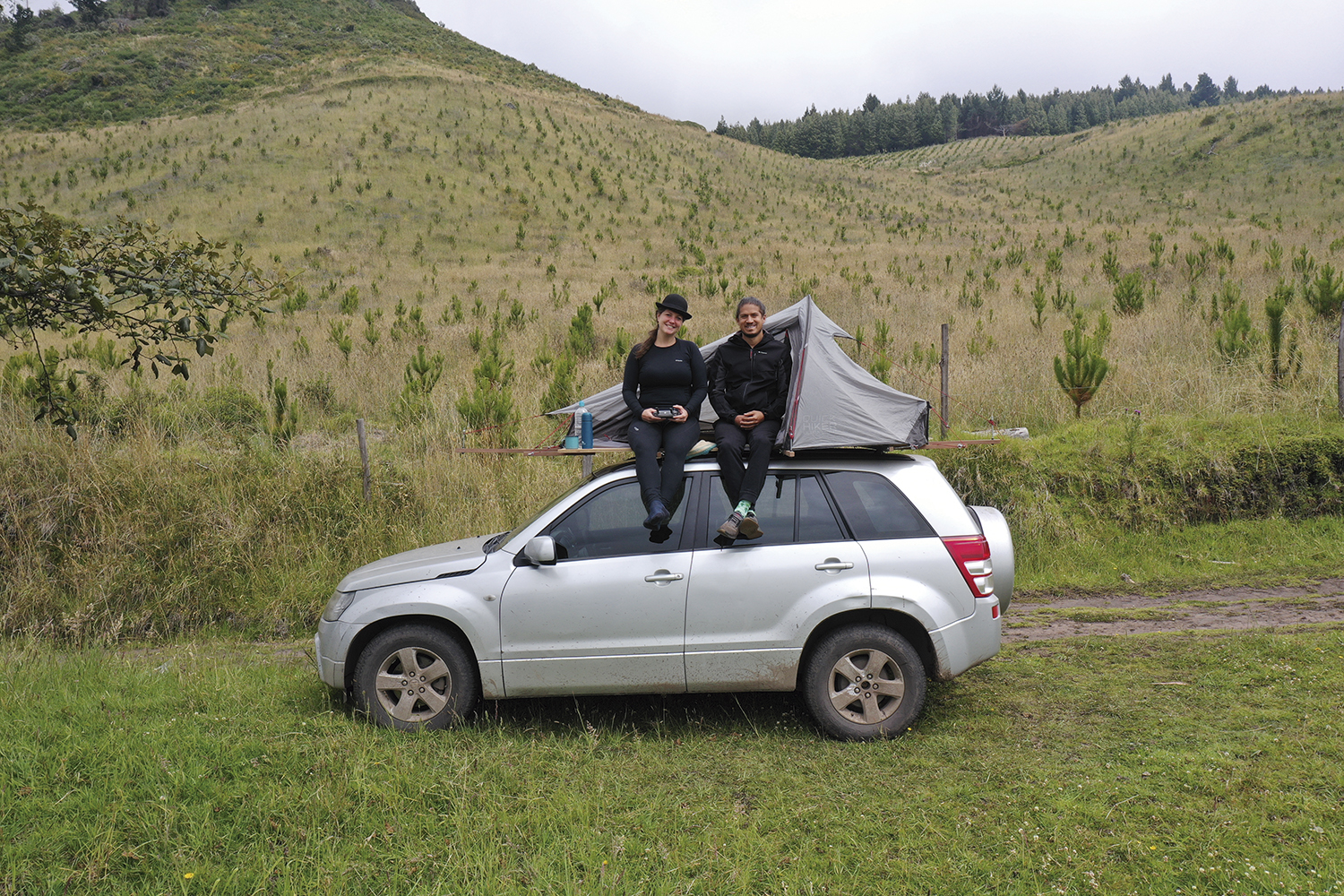Architecture as a Social and Political Practice
Ruta 4 Taller is an academic platform and a moving research space based in the city of Pereira, Colombia. Drawing from experimentations with matter, explorations on processes, collective provocations, and affective connections to the landscape, they develop strategies for bridging symbolic representations of the territory with the space that will be constructed; grounding their decisions in a political, cultural, geographic, and historic correspondence.
Education
Formation
The sum of unanswered questions in our academic training, new interests arising from other kinds of knowledge, and the discomfort with the ways in which architecture operates in our region, motivated us to create our own space in 2014. It was conceived to encourage participation and narrate stories in which architecture can provide evidence of a landscape that expresses a community’s popular knowledge from a technical point of view; where materials are proof of a geographic understanding. We believed that the act of constructing could stimulate the appearance of cultural manifestations surrounding that knowledge.
So, nine years ago, we got together to understand our practice as part of an expanded geography into the cultural and political dimensions.
Along this path, we’ve become part of a team with heterogeneous concerns, managing to undertake various lines of research that have, in turn, allowed us to stimulate critical thinking and integrate it across urban planning and architecture in different Latin American regions.
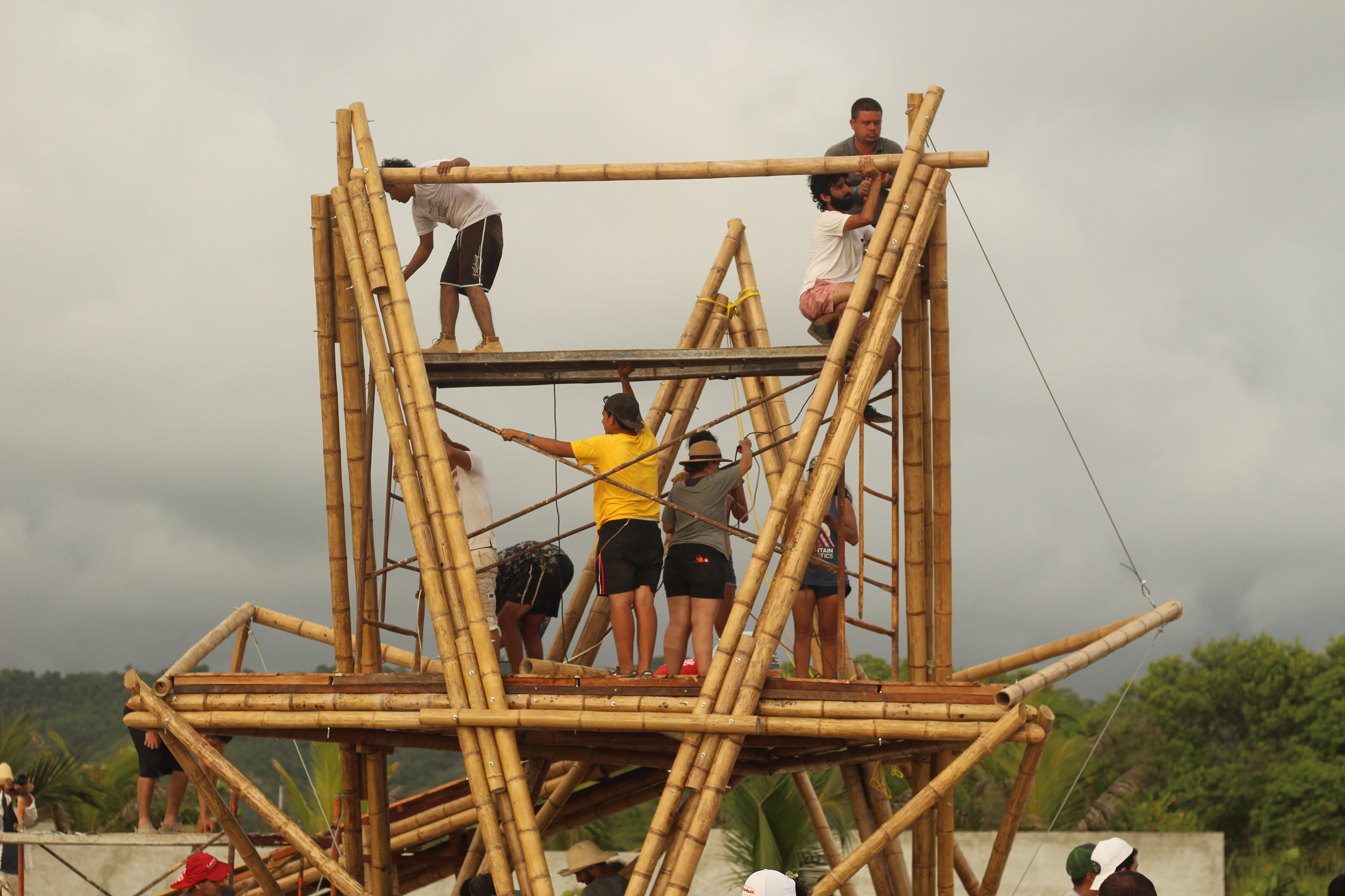
Simultaneous work among the participants of the TSL Canoa (Ecuadro) while the mooring beams of the structure of the second level of the dreamcatcher are being installed. Workshop participants ruta4 and Natura futura.
Photo: Paulina Ojeda. Courtesy: Ruta 4.

Constructive model of the project Maquina del Paisaje. Ephemeral installation produced in the Urbanautas 2019 workshop, team led by Natura Futura and Larva estudio.
Photo: MediaCorv. Courtesy: Ruta 4.

Don Julio and Grande, community leaders from Plumon Alto, snooping on the children's game from inside the Casa Ensamble Chacarrá.
Courtesy: Ruta 4.

Espacio interior del espacio comunitario, dia del acabado final de piso.
Cortesía: Ruta 4.
Teaching
We are interested in understanding our work and the reflections that accompany it as part of a school that has been created and shaped over time. Ruta 4 Taller has been conceived of as an academic platform based in the city of Pereira, Colombia, from where we have produced a framework for participation and experimentation, which has enabled a collective reflection regarding the infinite variables in the learning process and their applications in different territories.
In this sense, we understand academic environments as experimentation and exploration workshops, and research processes as a shifting path that is channeled through projectual intentions. In this way, common goals can be created, where the pedagogic practice recognizes the diversity and the interests of the team. That is the point of departure for the concrete ideas that are then applied territorially.
In another sense, we are interested in recognizing the need for diluting this strict idea surrounding plans and programs in architecture schools, to enable the expansion of new research routes that bring the contexts closer into contact and that provoke discussions on the role of architecture regarding the urban and rural phenomena that assail us presently.
We understand our professional practice as part of an artistic and learning practice that is malleable and emerges from the need to explore diverse ways of approaching an initial idea.
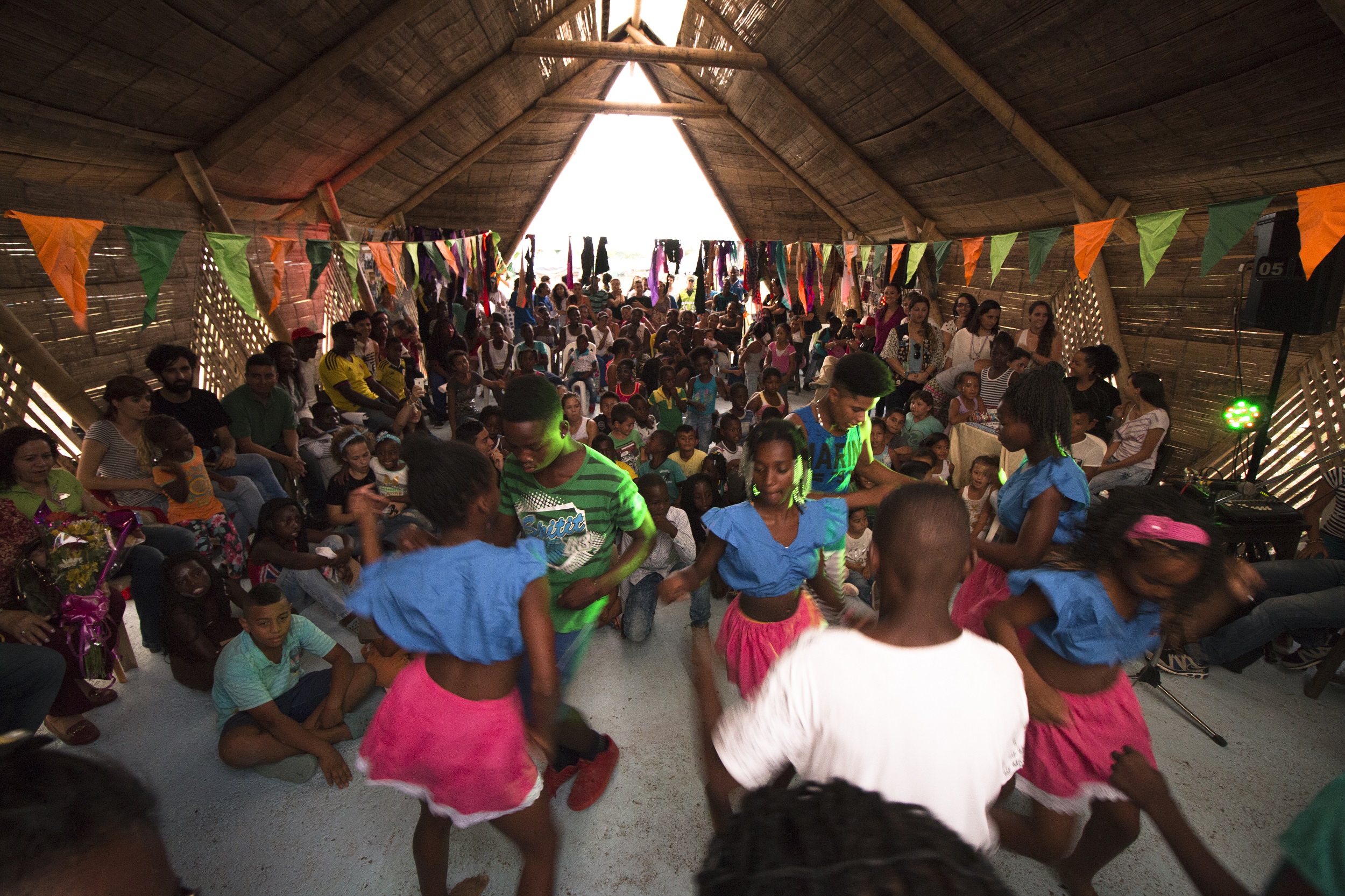
Inauguration celebration and handover of the space to the community. Traditional dancing of the Colombian Pacific culture and fashion show by the young people of the Plumón Alto community.
Courtesy: Ruta 4.
Learning
As a studio, we are interested in traveling through various Latin American territories with different political and cultural ways of organizing themselves. Through this, we expand our archive of images and events, which allows us to take these geographies as references that we can implement when managing or designing a project.
We notice the self-organization systems and the ancestral knowledge that can be found in the neighborhoods. Cultural actions emerge around these topics, which accompany the self-construction actions that take place in Latin American territories; this is why we’re interested in recognizing in these phenomena an act of cultural transmission that occurs between communities. This allows us to nurture the affective bonds between the people who are part of this collective idea and for us to spark a dialogue with the landscapes and the spaces.

Ephemeral shelter device built in the Urbanautas workshop. The space being used by the children of the foundation El Comienzo del Arcoiris on the opening day.
Photo: MediaCorv. Courtesy: Ruta 4.
Aside from this system through which we approach territories, we are interested in fostering the collective calling regarding communal ideas that may be nurtured by other narratives that don’t come from an architectural background. It’s about understanding the practice as part of a social weaving that must not be unfamiliar with the effects of buildings in their contexts, and, taking off from there, creating sensitive dialogues with the places themselves.
As a team, we understand ourselves to be immersed in a constant learning state. It has been fundamental to create alliances with other individuals and/or collectives that consider the habitat and the architectural practice as part of a social and political fabric.
Processes
Beginnings
We are interested in mobilizing ourselves, firstly, out of concerns that emerge collectively within our studio in the wake of reflections derived from projects and voyages. Starting with these premises, we approach the sites in a sensitive way, so that we may propose ideas that consider the everyday as part of a cultural weaving, where architecture complements the actions given in a certain landscape and place.
While each approach varies, in our exercises, drawings, maps, models, narratives, and photographs emerge as strategies that allow recognizing the places on various scales of approximation. These explorations lead to intentions fueled by the community and other agents, in participatory scenarios created to enrich each initiative with new perspectives provided by the diverse roles within the collectives.
We aim to shape these variables into an architecture that gathers popular knowledge from the sites and our intuition, bringing into existence public and private spaces that call for collectivity.
Here, we are part of this collectivity to develop self-management strategies, participatory design, and construction or self-construction projects. Our primary interest lies in collaborating on projects aimed at improving the habitat, where architecture is understood as part of a system that transcends the physical-spatial realm.
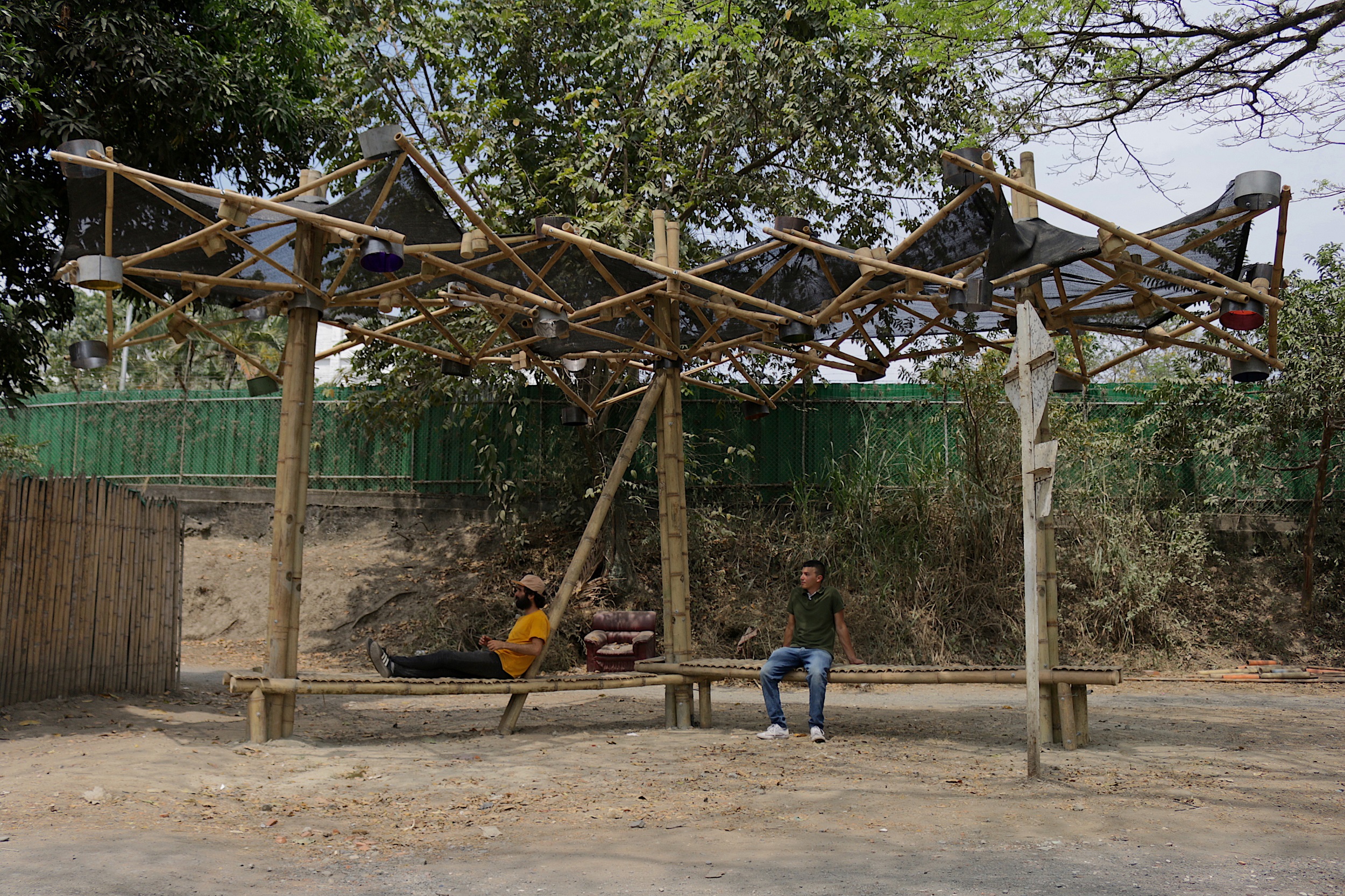
Ephemeral device built in the Urbanautas workshop: a space for waiting for the bus at the entrance of the village of Puerto Caldas.
Courtesy: Ruta 4.
Questions
Over time, we have increasingly incorporated intuition into the thinking and creative exercises we undertake. We aim to establish a sensitive encounter with the ideas that permeate us: narrating intervention sites through drawings, texts, and photographs, to settle down our interaction with the landscapes. This initial approach is valuable as it allows us to speak of a felt and experienced place, which over time is enriched by collective narratives and common urban imaginaries.
We have been consolidating our practice as a malleable exercise that understands the context as a variable operational field due to the social and political contingencies of the places. In these endless variables of the sites, errors constantly arise; this circumstance has led us to redefine the idea of a finished and conceived work, to delve into a process that is part of a malleable idea. To articulate the work and, at the same time, allow for change, we are interested in identifying anchors from conceptual and projectual nodes, enabling the integration of changing ideas and provoking new resilient spatialities, where the symbolic prevails as part of a collective architecture.
Strategies
We start from the concept of common-unity as our working principle, proposing a collectivity that gains more character when individuals empower themselves with their knowledge. This allows us to recognize the abilities of each participant in a common idea and thus enhance the collective work.
The approach to collective work varies according to the project's context and the interests of the community it encompasses. In this sense, we understand the community as a group of people coming together for a specific action, where common agreements prevail.
It is essential to recognize the parts and roles to make visible the diverse skills within the collective; methodologies are then drawn up to group us into teams based on our affinities, to direct actions towards a common goal. These decisions are made in assemblies convened to socialize the ideas proposed by sub-teams and to open up the opportunity for participation and negotiation of ideas with the entire community, including those who are involved in the project but aren’t necessarily part of the leadership processes.
While there isn’t a fixed methodology, we are interested in understanding the participation process as a toolbox of strategies and knowledge, where we have compiled actions, activities, and possible materials that allow us to interact in a playful and everyday manner with people to rediscover places and invigorate participation, without political, age-related, or racial delimitations. This allows us to establish a variable methodology that blurs the steps to follow and instead allows for different paths of work and modes of organization.
Procedures
The architectural projects we undertake seek to transcend the physical fact and acknowledge cultural manifestations, the articulation of organizational processes, and support in the management, ideation, execution, and activation of spaces.
We aim to create festive scenarios that enliven neighborhood activities and allow us to engage in everyday spaces, where we can spark conversations with greater trust and thus establish a better approach to the place and its community. We’re interested in learning about the political organization of places, the powers and counterpowers that reside therein, to provoke—from architecture—new organizations and leaderships that drive ideas and positive impacts on the territories.
Dialogues
Our way of working is built on multiple relationships that allow us to have different perspectives and broaden our outlook on the professional practice of architecture. In popular knowledge, we have found explorations and possible answers to questions about technical processes, which is why we are interested in establishing close relationships with self-builders and artisans in the areas we visit and intervene. Likewise, we welcome different disciplines into the process to ensure that physical work is integrated with the cultural and political manifestations of the place. We have learned not to walk alone, and in each process, we are accompanied by people with diverse interests and motivations.
Our team has been joined by individuals through volunteering, professional practice, collaboration, and co-creation; each involvement implies a different degree of temporal commitment to the processes we develop. In these teams, each person does what they do best, where their academic, professional, and practical knowledge and experiences allow them to contribute relevantly to the process.

Interior of the Amairis project, showing the storage spaces and the relationship of the inner space with the lake outside from the main façade. Project materials: bamboo, brick and metal.
Photo: Federico Cairoli. Courtesy: Ruta 4.
Works and Projects
In Progress
We have currently begun a process of reflection and analysis on the approaches we have taken in architectural procedures and the urban endeavors we have pursued over the years. These initiatives have been primarily located in rural areas and peripheral neighborhoods, which have exposed us to territories with social and political complexities increasingly reflected in their self-organizational processes. Our role as architects involves territorial reflections on the spaces we engage with, and our work is understood as a political action, prioritizing the common good, where everyday life and diversity become more significant in the places we build.
Presently, we are more intensively involved in academic processes, understanding this environment as a possible field for reflecting on contemporary practices and proposing actions aimed at preserving traditions, revitalizing systems rooted in the popular, and shaping communities that see collective action as the possibility for configuring an architecture integrated with the specific geographies.
We feel that it is a pivotal time for our practice, so we want to critically review the processes we have proposed to redefine the new approaches that the team decides to undertake.
In Retrospect
Some relevant exercises and experiences that have shaped our body of work include, for example, "Espacios de Paz" in the city of Punta Arenas, Venezuela, as an initial approach to participatory processes. This project allowed us to test collective work methodologies where an interdisciplinary team was assembled to build a community architectural space. Years later, we became involved in the "Casa Ensamble Chacarrá" project as a collective endeavor in the city of Pereira, where we explored community self-organization systems that allowed us to understand architecture as part of a political framework; in it, we created a digital platform for cultural and social agents in the city. This process was interrupted due to internal conflicts arising from the political tensions over land in our country; this reaffirmed the importance of communal action as part of a political effort, where spaces catalyze processes that view popular education as a path to opening new possibilities for children and youth in an untamed context.
Years later, based on these learnings, we embarked on the "Amairis" tailoring workshop project in a peripheral community. It was an initiative by a group of women to launch their own business through productive actions. Through self-management, they sought to create an autonomous space that would contribute to the cultural activities of the community center to which they belong. Our role was directed at sparking social organization systems and the recovery of local construction systems to encourage the participation of local artisans and create a spatial experience that prioritizes the landscape.
In another line of thought, over the years, we have been consolidating academic processes of methodological experimentation, seeking to address issues close to social problems. We see the academic practice as having a significant responsibility to propose a redefinition of space and the importance of this device as part of a cultural fabric.
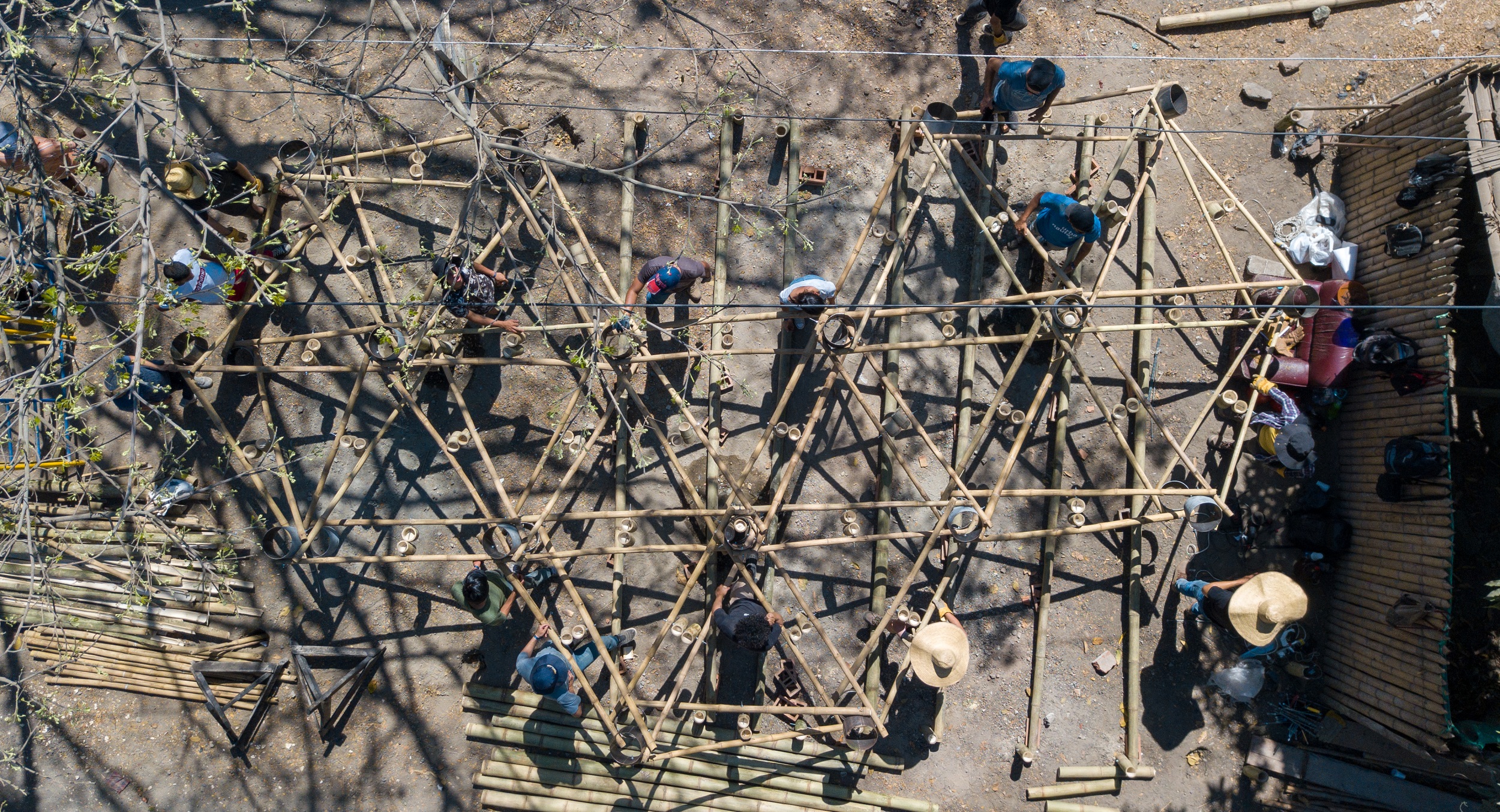
Top view of the Arboiris project, an ephemeral installation developed in the Urbanautas 2019 workshop, coordinated by Aqua Alta and Oficina Suramericana de Arquitectura.
Photo: MediaCorv. Courtesy: Ruta 4.
Contexts
We see ourselves as traveling organisms who are willing to recognize diverse cultures and their nuances, to propose exercises that stimulate and propel social processes. On the other hand, we seek to blur the line between public and private in our projects, trying to think up open spaces that call for associativity on diverse scales of approaching the context. Therefore, we are ever more attracted to thinking about architecture as part of the landscape.
